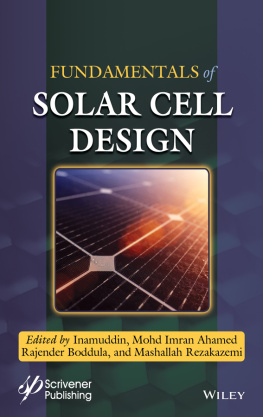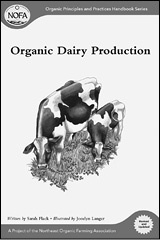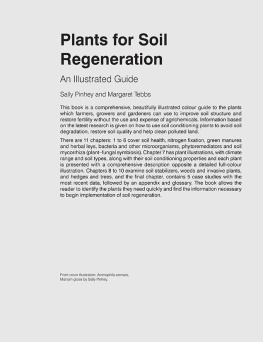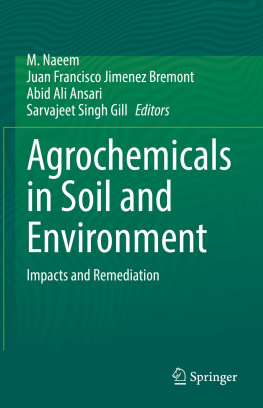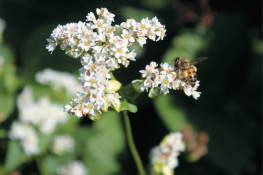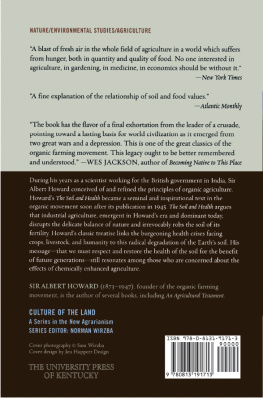
Scrivener Publishing
100 Cummings Center, Suite 541J
Beverly, MA 01915-6106
Publishers at Scrivener
Martin Scrivener ()
Phillip Carmical ()
Biofertilizers
Study and Impact
Edited by
Inamuddin, Mohd Imran Ahamed
Rajender Boddula
Mashallah Rezakazemi

This edition first published 2021 by John Wiley & Sons, Inc., 111 River Street, Hoboken, NJ 07030, USA and Scrivener Publishing LLC, 100 Cummings Center, Suite 541J, Beverly, MA 01915, USA
2021 Scrivener Publishing LLC
For more information about Scrivener publications please visit www.scrivenerpublishing.com.
All rights reserved. No part of this publication may be reproduced, stored in a retrieval system, or transmitted, in any form or by any means, electronic, mechanical, photocopying, recording, or otherwise, except as permitted by law. Advice on how to obtain permission to reuse material from this title is available at http://www.wiley.com/go/permissions.
Wiley Global Headquarters
111 River Street, Hoboken, NJ 07030, USA
For details of our global editorial offices, customer services, and more information about Wiley products visit us at www.wiley.com.
Limit of Liability/Disclaimer of Warranty
While the publisher and authors have used their best efforts in preparing this work, they make no representations or warranties with respect to the accuracy or completeness of the contents of this work and specifically disclaim all warranties, including without limitation any implied warranties of merchant-ability or fitness for a particular purpose. No warranty may be created or extended by sales representatives, written sales materials, or promotional statements for this work. The fact that an organization, website, or product is referred to in this work as a citation and/or potential source of further information does not mean that the publisher and authors endorse the information or services the organization, website, or product may provide or recommendations it may make. This work is sold with the understanding that the publisher is not engaged in rendering professional services. The advice and strategies contained herein may not be suitable for your situation. You should consult with a specialist where appropriate. Neither the publisher nor authors shall be liable for any loss of profit or any other commercial damages, including but not limited to special, incidental, consequential, or other damages. Further, readers should be aware that websites listed in this work may have changed or disappeared between when this work was written and when it is read.
Library of Congress Cataloging-in-Publication Data
ISBN 9781119724674
Cover image: Wikimedia Commons
Cover design by Russell Richardson
Set in size of 11pt and Minion Pro by Manila Typesetting Company, Makati, Philippines
Printed in the USA
10 9 8 7 6 5 4 3 2 1
Preface
Great attention has been paid to reduce the use of conventional chemical fertilizers harming living beings through food chain supplements from the soil environment. Therefore, it is necessary to develop alternative sustainable fertilizers to enhance soil sustainability and agriculture productivity. Biofertilizers are the substance that contains microorganisms (bacteria, algae, and fungi) living or latent cells that can enrich the soil quality with nitrogen, phosphorous, potassium, organic matter, etc. They area cost-effective, biodegradable, and renewable source of plant nutrients/ supplements to improve the soil-health properties. Biofertilizers emerge as an attractive alternative to chemical fertilizers and as a promising cost-effective technology for eco-friendly agriculture and a sustainable environment that holds microorganisms which enhance the soil nutrients solubility leading a raise in its fertility and stimulate crop growth and healthy food safety.
This book provides in-depth knowledge about history and fundamentals to advances biofertilizers, including latest reviews, challenges, and future perspectives. It covers fabrication approaches and various types of biofertilizers and their applications in agriculture, environment, forestry, and industrial sectors. Also, organic farming, quality control, quality assurance, food safety, and case studies of biofertilizers are briefly discussed. Biofertilizers physical properties, affecting factors, impact, and industry profiles in the market are well addressed. This book is an essential guide for farmers, agrochemists, environmental engineers, scientists, students, and faculty who would like to understand the science behind the sustainable fertilizers, soil chemistry, and agroecology, etc.
focuses on the various action mechanisms observed in microorganisms, those that drive effective biofertilizer functions for forestry-related utilization. Besides, the chapter discusses the factors influencing the success of forestry-related biofertilizer applications as well as the current use and prospects of biofertilizers in the forestry sector.
highlights the impact of applying biofertilizers on horticultural crops including the possible mechanisms, leading to improved crop growth and stress tolerance. Possible challenges of biofertilizer application and recommended solutions to these problems are also discussed to ensure the efficient use of biofertilizers in the horticulture industry.
discusses various microorganisms which as act as biofertilizers and also the nitrogen-fixing bacteria including different symbiotic and asymbiotic nitrogen-fixing microbes and other substitutes for easy making of biofertilizers. The major focus is given to innovative methods, for example, growing of microorganisms, accumulation of microorganisms, and conveniences for distribution, applying, and framing of microorganisms for moving from greenhouse and laboratory to field test.
highlights the usefulness of organic manure in biofarming. Various types of agrochemicals have spoiled our life, environment, and ecosystem. This chapter provides a detailed discussion about how organic manure can save the life of our earth and how it is better than agrochemicals.
reviews the scientific literature on environmental phosphorus pollution and mechanisms of phosphate solubilization through intact bacteria and fungi or their enzymes. Moreover, inoculation methodologies, factors affecting the inoculum efficiency, and applications of single or multiple species as promising biofertilizer components for sustainable and ecological farming practices are summarized.
reviews plant-microbe associations occurring both exo- and endophytically on different plant species. The beneficial and pathogenic outcomes of these interactions are discussed, highlighting the microorganisms and the plants involved. Furthermore, the importance of research of these interrelationships is considered concerning use in agriculture for the development of agricultural agents.
discusses the different formulation technologies of biofertilizers used to mitigate the harmful effects of chemical fertilizers. The complete formulation process is discussed, highlighting the significance of each step, i.e., types of selected microbes, choice of suitable carrier, and addition of sticking materials while unifying the biofertilizer formulation.
describes the scope of exploiting efficient transgenic microorganisms produced by genetic engineering strategy as potential biofertilizers to enhance the yield of crops through the sustainable farming approach. Furthermore, environment-friendly benefits of utilizing various types of microorganisms alternative to chemical fertilizers in improving soil fertility of agricultural lands are also emphasized.
Next page

